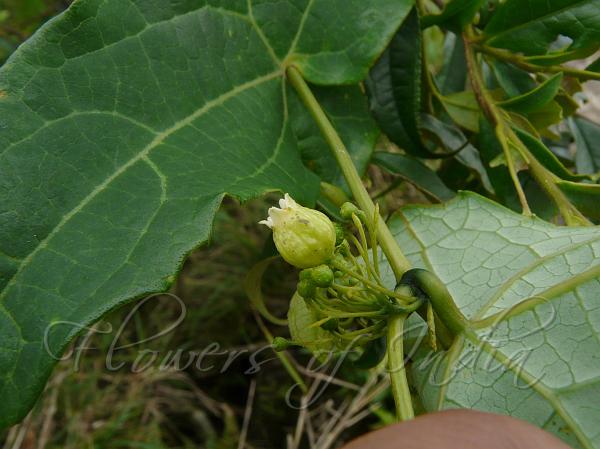|
| Himalayan Creeping Cucumber |
|

|

| File size | 511587 |
| Original date | 5/18/19 12:41 PM |
| Resolution | 2048 x 1536 |
| Flash | Flash did not fire, auto |
| Focal length | 4.6mm |
| Exposure time | 1/320s |
| Aperture | 5.6 |
| Focus Distance | |
| Metering Mode | Spot |
| Camera make | Panasonic |
| Camera model | DMC-FZ18 |
| Sensor type | OneChipColorArea |
|
|
|
|
Photo: |
Botanical name: Solena heterophylla Family: Cucurbitaceae (Pumpkin family)
Synonyms: Bryonia sagittata, Zehneria heterophylla
Synonyms: Bryonia sagittata, Zehneria heterophylla
Himalayan Creeping Cucumber is a climber with stem and
branches hairless. Leaf-stalks are slender, 4-10 mm. Leaves are very
variable, ovate, oblong, ovate-triangular, or arrow-shaped, undivided
or 3-5-lobed, leathery, 8-12 x 1-5 cm, below densely bristly or almost
hairless, above densely bristly or scabrous, base heart-shaped, margin
entire or toothed, tip blunt or tapering. Tendrils are slender. Male
flowers borne in umbels, on very short flower-cluster-stalks,
10-20-flowered. Flower-stalks are 2-8 mm; calyx tube 3-5 mm, about 3 mm
in diameter; segments slender pointed, 0.2-0.4 mm. Flowers are yellow
or yellow-white; petals triangular, 1-1.5 mm, tip blunt or pointed;
filaments thread-like, about 3 mm. Female flowers are usually solitary;
flower-stalk 2-10 mm, finely velvet-hairy; calyx and flower as in male
flowers. Fruit is red-brown, broadly ovoid, oblong, or nearly
spherical, 2-6 x 2-5 cm. Himalayan Creeping Cucumber is a found in
mixed forests, thickets, grasslands, roadsides, mountain slopes, at
altitudes of 600-2600 m, in NE Afghanistan, Himalayas to Bhutan and SE
Asia. It is also widely found in rest of India. Flowering: May-August.
| Identification credit: Tabish | Photographed in Cherapunjee, Meghalaya, Govindghat-Ghangria route, Uttarakhand & Rajouri, J&K. |
• Is this flower misidentified? If yes,